It was the year 2001 when Ipswich Town had just finished a great season in the Premier League after being promoted from the First Division.
That season, they finished fifth in the table, which meant that they could enter the first qualifying round of the UEFA Cup.
George Burley, the coach, was quite beloved given the achievement of such a good season for the team, especially after what was their first season after promotion.
However, the following year was going to be a nightmare that didn’t seem to have started that way.
Ipswich defeated a European great, Inter Milan, 1-0 in the first leg of the third qualifying round of the UEFA Cup.
They were then beaten as the Italians came back with a 3-1 result at the Giuseppe Meazza.
Through performance and effort, they came close to achieving another great moment, but things began to unravel as time passed, and the team was relegated to the second tier.
That was the last year they would play in the Premier League.
17 years later, consecutively playing in the Championship without having achieved promotion to the Premier League again, something even worse would happen for Ipswich.
The worst season in years was happening — they were relegated to the third division, finishing at the bottom of the league.
That same season, a man who would be important later on for Ipswich, would become one of José Mourinho‘s coaches at Manchester United: Kieran McKenna.
Since he arrived in 2021 to become head coach of the Tractor Boys, he has taken charge of 52 games, overseeing 28 wins, 14 draws and 10 losses.
Before his arrival in 2021/22, the team had won seven games, drawn eight and lost eight.
After the dismissal of Paul Cook and the entry of McKenna, the team remained between ninth and 11th, registering 10 wins, nine draws and four losses.
The start of the 2022/23 campaign has been impressive.
They remain in second place after 22 games, achieving 13 wins, six draws and three losses.
They’ve scored 41 goals — the most scored in the league tied with Plymouth Argyle — and conceded 22 goals.
Additionally, their way of playing has caught the eye.
They favour lengthy periods of possession and rapid progressions after surpassing the first line, relying on the technical quality of players such as Wes Burns, Cameron Humphreys and Conor Chaplin — to name a few.
This will be a tactical analysis to examine Kieran McKenna’s attacking tactics in the Ipswich team, as well as an analysis of the players’ roles, what he has to offer and what must continue to improve.
Holding the ball at the back and releasing creativity behind
The offensive approach of Kieran McKenna’s team has been fascinating.
His pieces have meshed with a system that lends plenty of freedom for players to create and move around the field.
However, there are several principles to highlight within this great spell from Ipswich Town.
Working with José Mourinho is noticeable in some of his ideas — not all, but in some — especially in terms of the idea of waiting for opponents with the ball, before then aggressively breaking the lines and standing in the rival’s field for less than five seconds after the pass, creating plays within one or two touches.
Something common in the lower English divisions is this extremely direct football in which the long ball is fired forward, constantly looking for a target man or when the ball is played on the ground, looking to jump and skip lines in each idea.
McKenna tries to give the game a little pause, to dominate possession more and for his players to notice much better what is in front of them and decide whether to retain the ball, move it to one side or dynamise possessions.
Ipswich Town have played most of their games in a 3-4-2-1 formation, but that changes as soon as they get the first ball.
Janoi Donacien has become a very important player in the team thanks to his adaptation as a central defender but also in possession of the ball as a right-back who looks to constantly exchange channels with Wes Burns, who acts offensively as a winger well attached to the line, but with a positive synergy between these two that generate a lot of game.
With the ball, Ipswich put together a kind of 4-2-3-1, with a more inverted winger over the left and another who goes deeper and reaches the last line with penetrating carries and controls — this is normally Wes Burns.
The first passes are extremely important for the team since they are the ones that generate the attractions and the first movements so that the creativity is completely released a few seconds later.
The use of their goalkeeper, Christian Walton, in possession of the ball is quite positive.
The role sees the player make a few touches but with a lot of sense and always looking to attract someone close to release through the ground.
He normally tries to triangulate with his defenders and sometimes even looks to penetrate the midfield with progressive passes.
Although he is not constantly used in this role, he fulfils it well when needed.
One of the most important movements of the team is, as we can see in the first example below us, performed by the midfielders, Cameron Humphreys and Samy Morsy, who have formed an extremely fluid double pivot due to their movements off the ball where they attract and move the rival block to their liking.
They dominate and manage the tempo of the game with great ease and good reading of the game.
In this case, we see how Humphreys approaches low between goalkeeper and centre-back, in order to receive behind the first line of pressure, already close to the ball for him to turn and advance.
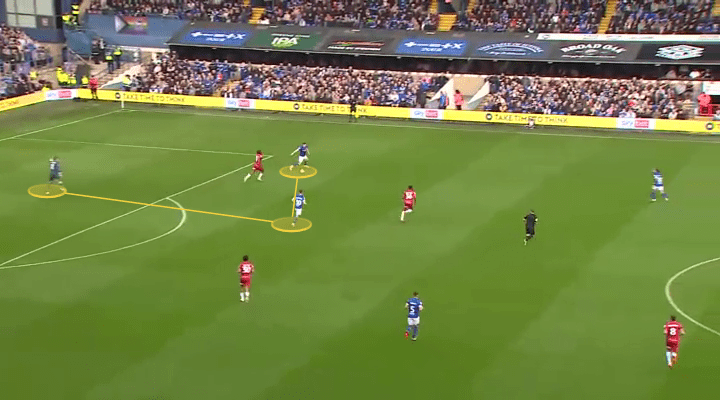
Here, we see another example with Luke Woolfenden, one of the best in the team at holding the ball for longer to open spaces behind, waiting for a long time for his rivals, to start their run, he finds the player on his side — in this case, Leif Davis, the left back who is lower on the pitch — and after that, he looks to progress between the lines and find a teammate.
Another thing that we can observe here is how Morsy is the midfielder approaching in this case, at the right of Woolfenden.
A rotation between him and Humphreys happens a lot to always be a support for his teammates for the first pass.
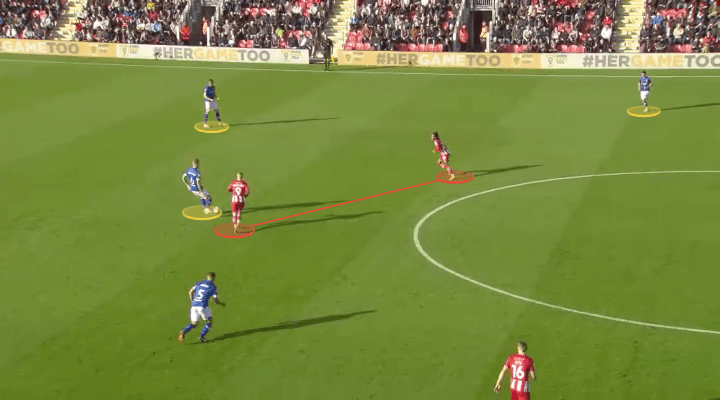
Their central defenders are allowed to progress, but one of the things we can see often from the team is that the executions are usually on the ground, not long or high.
They have eliminated this type of search in order to create plays in smaller spaces, with players who technically know how to overcome it with one-touch passes between them.
In this image, we see how Woolfenden is once again in charge of carrying out the build-up from behind.
He waits for the rival marking and is very brave to pass the ball through the central channels, over to Marcus Harness, the left winger who plays more inverted and joins as a midfielder in possession, at the same height as Conor Chaplin.
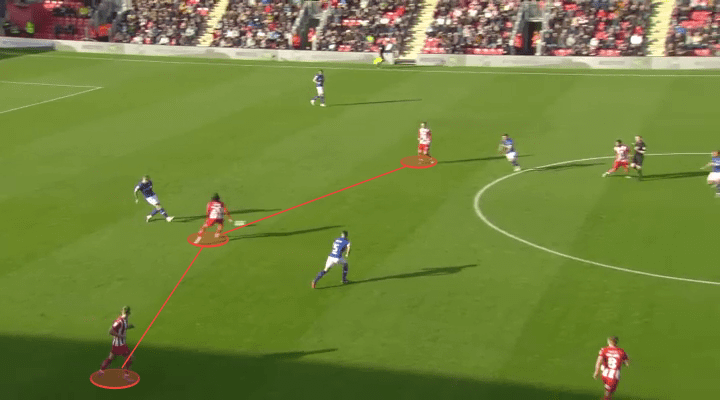
It’s not just Luke Woolfenden who progresses with his passes from behind, but also Cameron Burgess when he has started matches for Ipswich.
For a centre-back, he is quite aggressive to create new passing angles to then verticalize and find advanced players like Conor Chaplin or Marcus Harness.
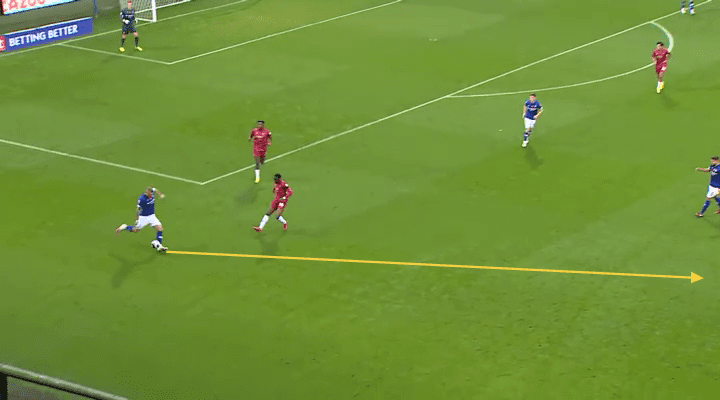
The consequent action of this pass from Burgess to the middle was received by Chaplin, one of the most important players in the team due to his creativity and freedom of movement, which generated a quick combination in a few touches, with a third-man encounter included in the link-up play, to create a threatening scenario for the rival.
As we can see, his pass was received by one of the midfielders, who then executed a pass to Marcus Harness with his first touch.
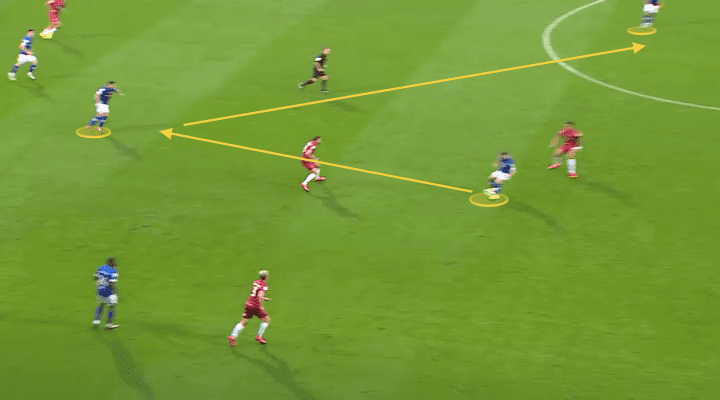
Another of the vital things within Kieran McKenna’s Ipswich Town build-up system is the low positioning of his full-backs, but that then changes a lot as the team manages to advance through the thirds.
Leif Davis and Jonai Donacien are extremely important in this.
With their simple positioning, they manage to keep rival players close to them so that they can later play passes to one of the advanced players who can receive with space to run.
As we can see in the figure below, Leif Davis positions himself low and the rival full-back approaches him.
The former Leeds United player receives the ball and his next act is to perform an inside pass with one of his teammates sitting in the half-space, before then activating his run into the space generated by this attraction.
The inside pass received by Harness was then released forward by him with a one-two combination that came out in a very dynamic way and with principles that have been handled during the season by McKenna and his boys.
One of the interesting things about when the ball is moved into the left wide zone is that many players approach — the inverted winger, one of the midfielders and a fairly open centre-back.
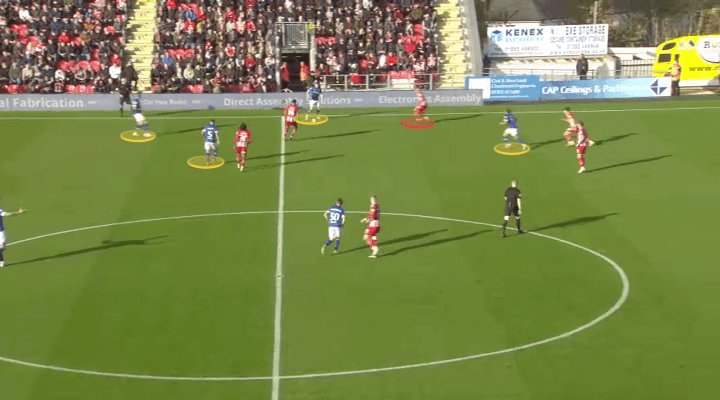
After the first progression from behind, what happens later is extremely exciting and fast.
Teammates approach the ball, others take the lanes they leave.
They move fluidly, and this creates many spaces to step progressively after each pass.
Marcus Harness, with his seven goals and two assists that have been key for the team, is also very important in his side’s possession play.
The way in which he approaches to support, release quickly or turn to carry and penetrate, is something very good that gives Ipswich a lot of ease and construction of the game.
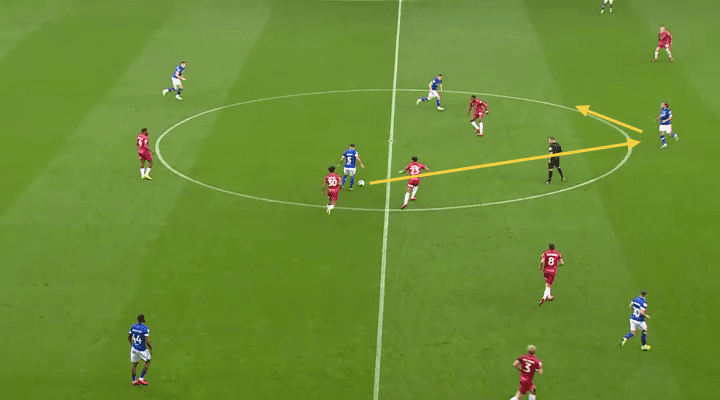
To talk about important players, we must include in the conversation one of those who has revolutionised this team, Conor Chaplin.
Naturally a #10, he has transformed in recent years — especially when he played at Barnsley — into a centre-forward.
With the arrival of McKenna, the ex-Portsmouth man returned to his position where he feels more comfortable, with more freedom to support possessions and also in the last third thanks to his speed to arrive.
Chaplin is extremely important thanks to his freedom and technique.
He can approach open areas as well as low ones, where he excels at his job of attracting close and triangulating with his teammates.
With his level, Ipswich have found easier ways to get to the goal, with his contributions both scoring, assisting and creating chances.
This example is perfect for what he is: He is not afraid of hiding the ball, nor is he afraid of approaching deep.
He leaves his comfort zones, and always accompanies supporting runs after the pass.
His dynamism helps to oxygenate his team so that they progress between the lines and can build according to his movements.
Although Ipswich run great collectively, what individual players offer is tremendous and important.
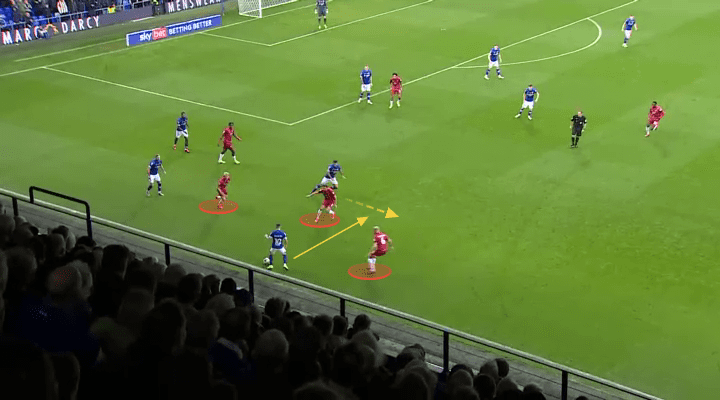
Ipswich Town have also proven to be an active team in the recovery.
The defensive positioning of their players wins a lot of balls through interceptions — after that, they look to quickly break the last line of the rival team with through passes that are usually clinical and very well executed on one wing by Leif Davis and on the other by Wes Burns or even Donacien, when he dares to reach the penalty area.
One of the players to watch in this template is Cameron Humphreys.
The quality of his control makes it easier for him to release players into space, something he does a lot on the pitch thanks to his vision.
But it is that Ipswich plays in a way that is almost automatic after recovering — in-behind movements from outside to inside that penetrate and break the opponent’s defensive line.
This is what a good team it’s structured by: collective principles well-executed with individual talent that offer creativity and something different as well.
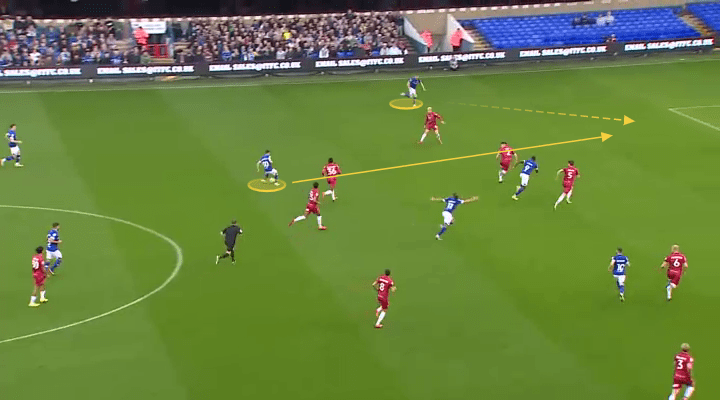
Another example of what they manage to do after recovery is taking one or two touches before moving to exploit space.
If they do not have anyone doing it on the wing to the inside, Freddie Ladapo, in his central target man role, attacks the space created aggressively.
Again, we see here Marcus Harness being vital in receiving the pass and then releasing another one for Ladapo.
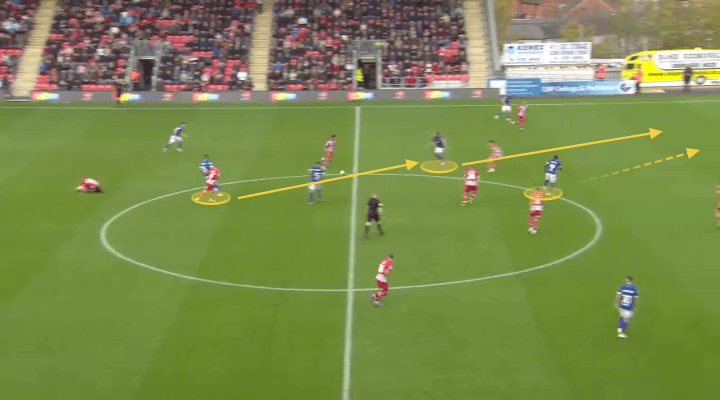
On the right flank, Donacien and Wes Burns have created a very positive chemistry that has forged, in this season and especially in recent games, a decisive duo in many of the goals and dangerous plays created by both.
Burns is normally the more wide player, hugging the touchline to stretch opposing blocks and get into 1v1 duels in which he is strong thanks to his speed and dribbling.
However, Donacien, who starts off as a central defender defensively, but in possession of the ball, ends up being a fairly incisive full-back, who activates the half-space and the wide channel that is exchanged with Burns as they reach the last third.
Between them, they try to activate with one-two combinations, which can bring them closer to the rival box where they always make crosses for Ladapo or Chaplin, one with his height and physicality, and Chaplin with his powerful arrivals to the box.
The power that Donacien carries is far superior to the players who try to steal the ball from him, which is why his team look for him to appear with underlapping runs and carry the ball forward for his team.
Even if he doesn’t get forward, he provides a great balance to cover ground behind.
Here, we can see how he performs a one-two that is constantly executed within McKenna’s system, in which the elements change positions but not the intention; this remains the same.
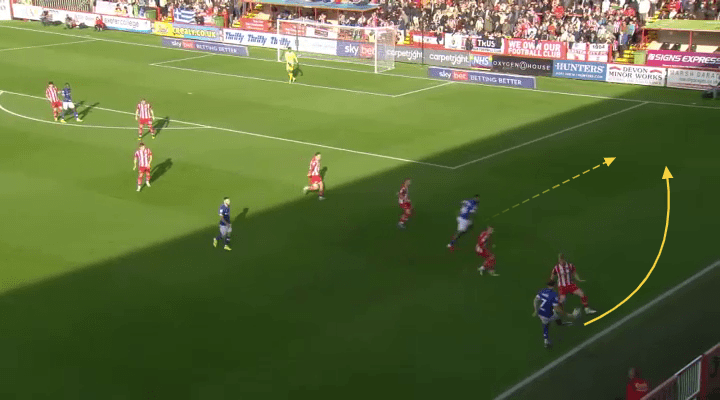
In the previous figure, Donacien was the player who received in space.
In the next one, it is Burns after the right-back placed himself wide.
This is something that has given the team a lot since they really earn too much threat with the confusion generated when the rival is marking, as both players are fast and powerful to run.
This kind of cut-back cross to the middle of the box is the most attempted and scored type of goal by Ipswich when creating chances.
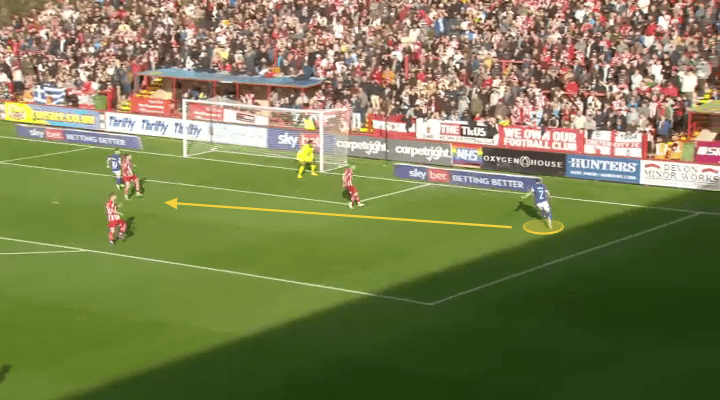
Set-pieces: How they managed to score nine goals through corner-kicks
Ipswich Town have scored nine goals from corners: The most any team have scored in League One this campaign.
This is an attacking constant and has accounted for 22% of the goals scored by McKenna’s men at the tournament.
The set-pieces have begun to take a lot of importance in football and much of this good form of the team is thanks to this preparation of the ‘laboratory plays’.
Let’s take a look at a couple of them.
In this one, we can see how they nurture the box of five players quite closely against five opponents.
This will disperse in a few seconds and will lead to a lot of confusion about who to mark for the rival.
It is something common inside the corner kicks in football, but it goes with something quite interesting inside for McKenna’s team.
There is only one player near the goalkeeper, pinning a defender with a key idea so they can score a goal.
The man who’s going to execute the decisive moment is Luke Woolfenden, which is helped from behind by Chaplin, looking to exchange the position and confuse the marker of Woolfenden.
Then questions are going to be asked of them.
Luke is then doing a curved run into the far post, and the other players are running into the near one.
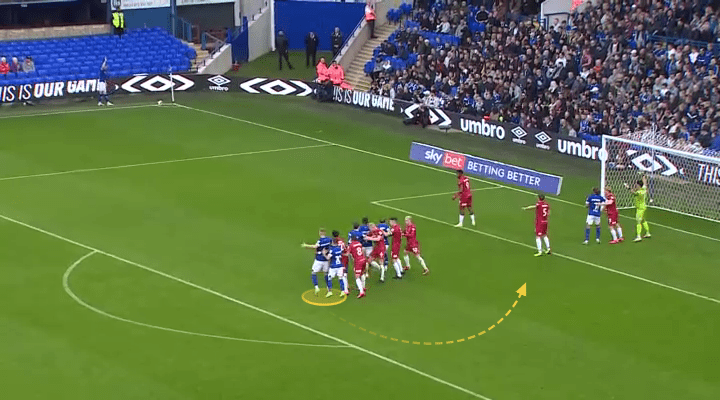
The corner results in this.
An in-swinging corner taken by Leif Davis who’s normally the corner specialist.
Wes Burns anticipates the delivery quickly and heads it to the far post where Woolfenden is free to score a tap-in.
Chaplin is very free in the middle of the box with a chance to score from a rebound as well.
Why? Well, the defenders had to ask questions with this Chaplin-Luke exchange.
One went behind and the other stayed, so two players try to mark Woolfenden but he won them the position, and then they saw Chaplin alone, so they were confused about what to do.
Plus, the only player pinning a defender close to the goalkeeper, was doing the job to make his teammate appear at the far post that free.
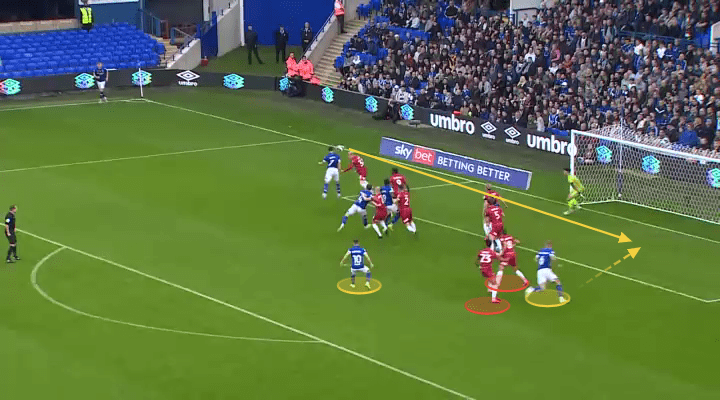
In another example, one player is pinning a defender at the goalkeeper’s box, meaning they will try to make a player appear at the far post again.
The main thing to look at here is the centre of the area, as Ipswich have formed a row of three players very tight, which their rivals don’t know how to mark it.
Chaplin is behind them inside his shadow role where he’s been undetectable and behind him again, a player lurking for the far post.
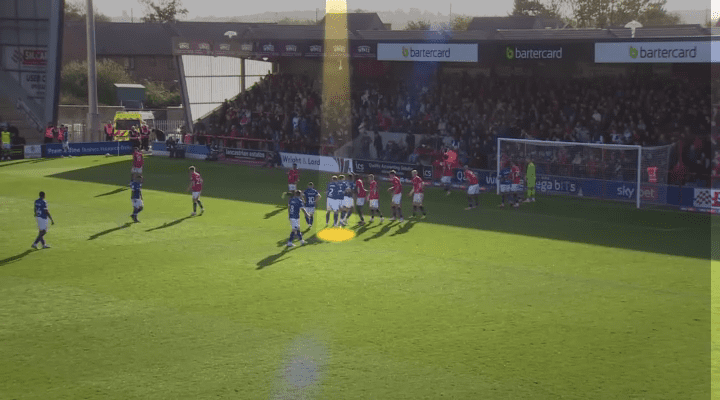
The corner, again with an inswinging delivery, has been taken.
The first player trying to anticipate the cross at the near post doesn’t hit the target.
However, once again, two players attack a very threatening zone of the box and this time one of them, George Edmundsson, receives the ball in his feet and shoots on target to then celebrate his goal.
If the ball was going to be headed by the player at the near post, this will be a similar goal to what we showed above, with the following run of a player to the back post.
However, it worked as a decoy to make one of his teammates appear freely, after making zig-zag runs after their three-row.
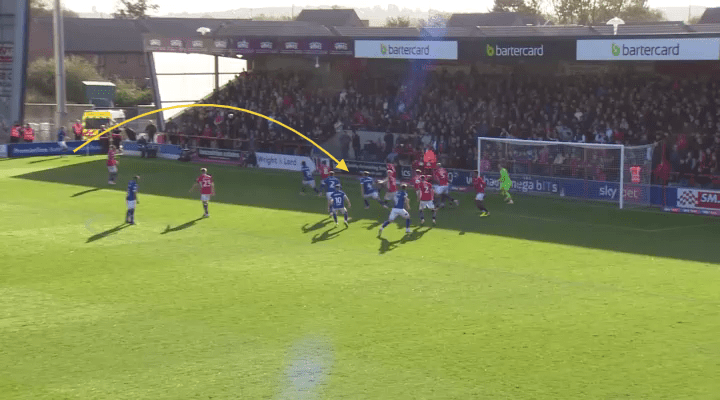
Conclusion
Kieran McKenna tactics at Ipswich Town have built a fairly competitive team that has had to face tough comebacks that they have achieved.
Through their attack, they created a machine to battle and win points, with clear movement principles in each area but with the freedom to generate — something that the footballers will be very grateful for.

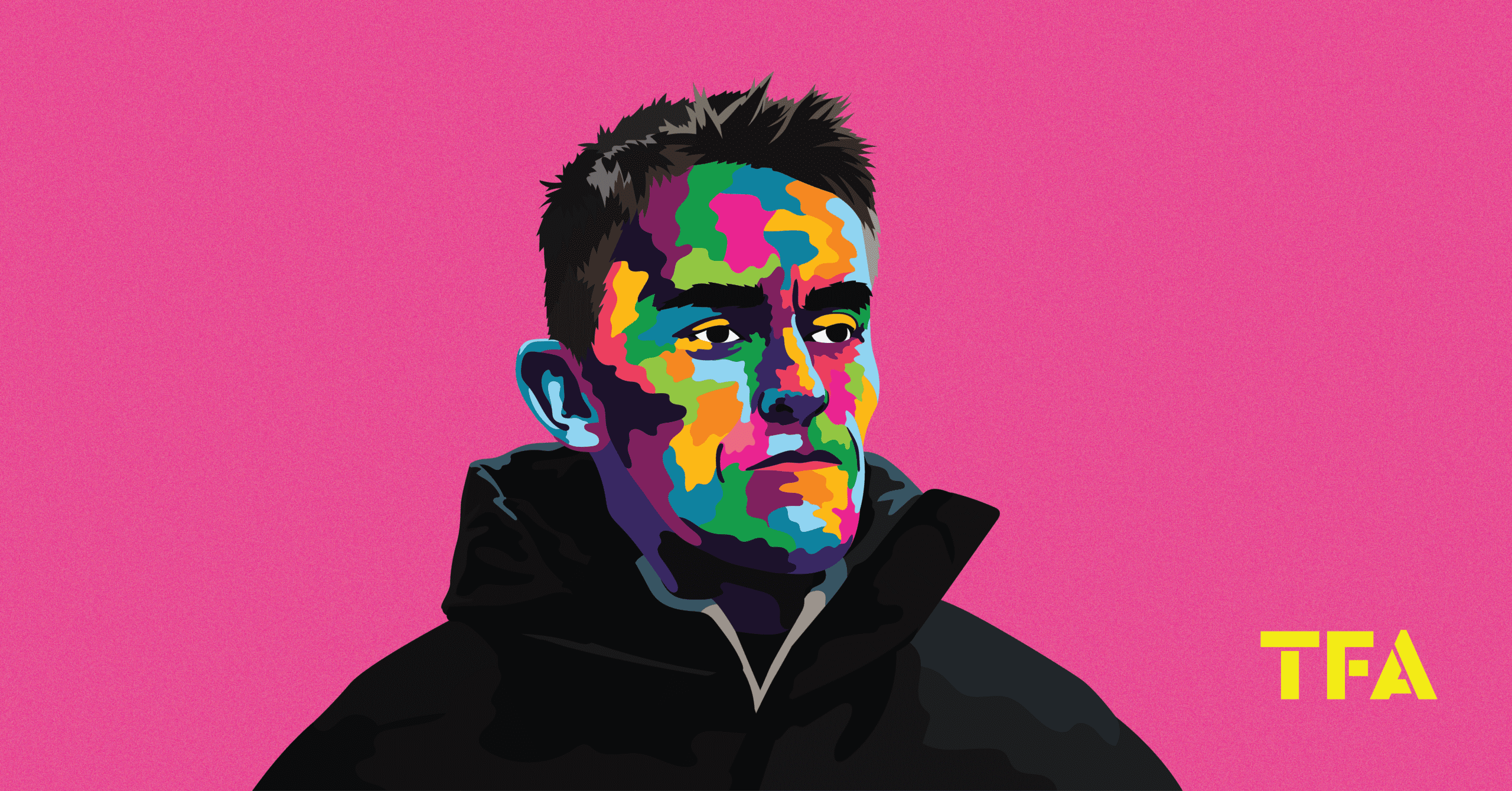




Comments